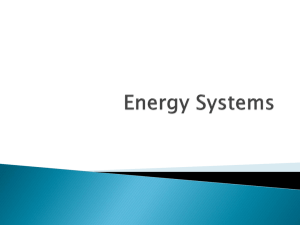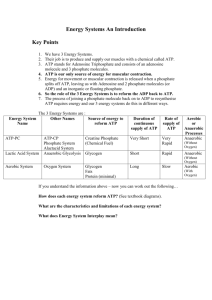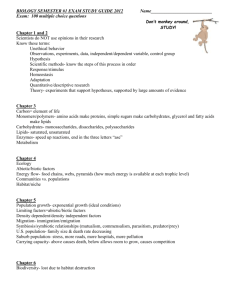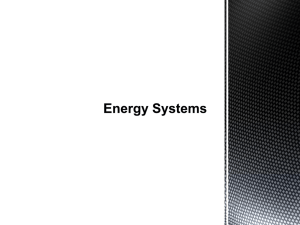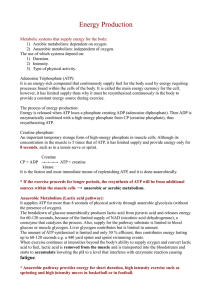Work and Energy (ATP) in Muscles
advertisement
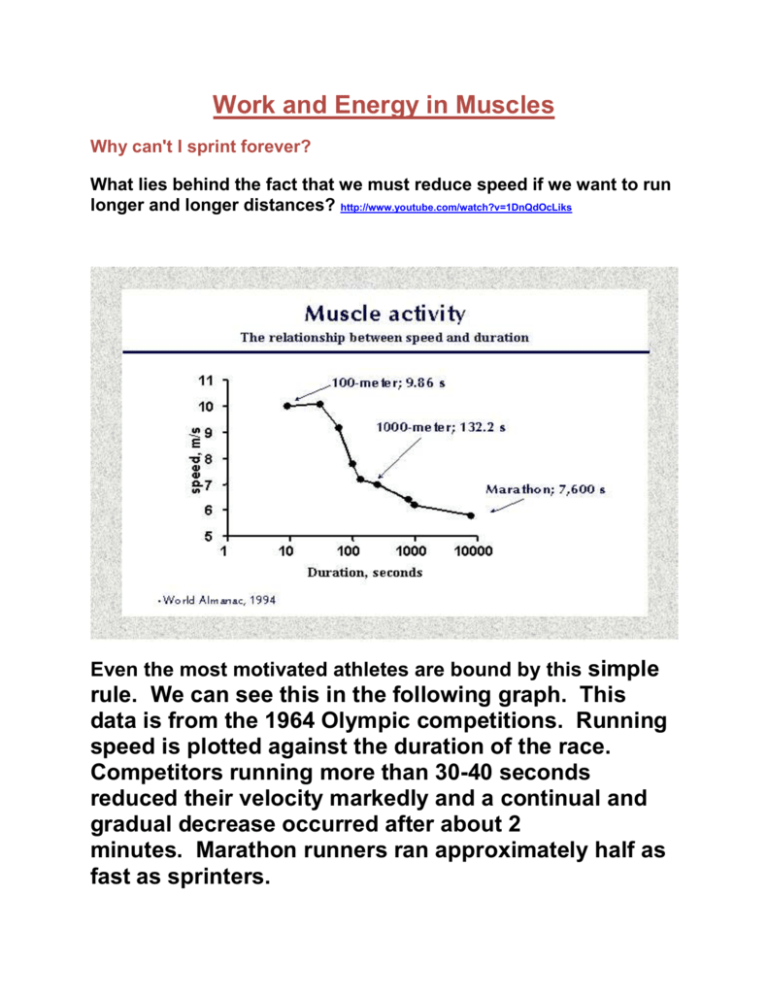
Work and Energy in Muscles Why can't I sprint forever? What lies behind the fact that we must reduce speed if we want to run longer and longer distances? http://www.youtube.com/watch?v=1DnQdOcLiks Even the most motivated athletes are bound by this simple rule. We can see this in the following graph. This data is from the 1964 Olympic competitions. Running speed is plotted against the duration of the race. Competitors running more than 30-40 seconds reduced their velocity markedly and a continual and gradual decrease occurred after about 2 minutes. Marathon runners ran approximately half as fast as sprinters. The explanation for this phenomenon is that differing energy sources are used by working muscles, the choice being related to the rate of usage. Stored highenergy phosphates energy (ATP-ADP and phosphocreatine/creatine phosphate CP) give the most rapid regeneration of utilized ATP. There is usually about 4-6 X more stored phosphocreatine than there is stored ATP. A 100 meter sprint takes less than 10 seconds . During this very short period the driving force is stored high-energy phosphate. The runners can perform almost without breathing, using energy stored as ATP or creatine phosphate (CP) in the active muscles. In contrast to long-distance runners, sprinters are often large, very muscular people. They are "specially equipped" for explosive function for very short periods. The energy supply for those who run from about 60 seconds to three minutes is also stored energy, but in this case it is primarily glycogen stored in muscles (and blood glucose) that provides energy. Glycogen/glucose must be broken down either aerobically (with oxygen) or anaerobically (without oxygen) to release things like pyruvate, which in turn can be made into lactate (lactic acid) or H20 and CO2 (depending on the pathway taken) to provide the ATP required for muscle activity. Metabolism of carbohydrates in muscle. Energy production, that is ATP synthesis from ADP and Pi, can occur anaerobically (without the use of oxygen out in the Sarcoplasm) or aerobically (using mitochondrial reactions and oxygen). These reactions, especially anaerobic metabolism, are quite rapid. The small amount of ATP produced anaerobically, is not enough to sustain life, except for a very brief period. Only carbohydrates (glycogen or blood sugar) can be used anaerobically. Neither amino acids nor fatty acids can be processed without use of oxygen. Muscles differ in their ability to produce ATP through anaerobic and aerobic reactions. “Fast-twitch” (white) muscle fibers with few mitochondria are designed more for anaerobic pathways. Those with many mitochondria are the aerobic, “slow twitch”, (Red fibers). Muscle cells also have a special protein that hangs on and stores oxygen, it is called “Myoglobin”. This gives muscle tissue a short supply of oxygen even before the circulatory system kicks in to meet the increased needs of the cell. MUSCLE ENERGY PATHWAYS : TIME 1-30 seconds 30 seconds To 2 minutes SOURCE OF ENERGY ATP PRODUCTION Stored ATP & Creatine Phosphate - Anaerobic 1:1 Ratio Anaerobic Glycolysis Glucose without Oxygen Little output but Rapid rate. Very Inefficient 2ATP per Molecule 2 minutes and beyond AEROBIC breakdown of Glucose 36 ATP Fats ___> 100 ATP Amino Acids ~ 15 ATP - If we compare aerobic cellular respiration of a single glucose to the anaerobic respiration of a glucose. (18 Times more efficient at releasing energy than that of anaerobic glycolysis – but much slower rate of reaction)

